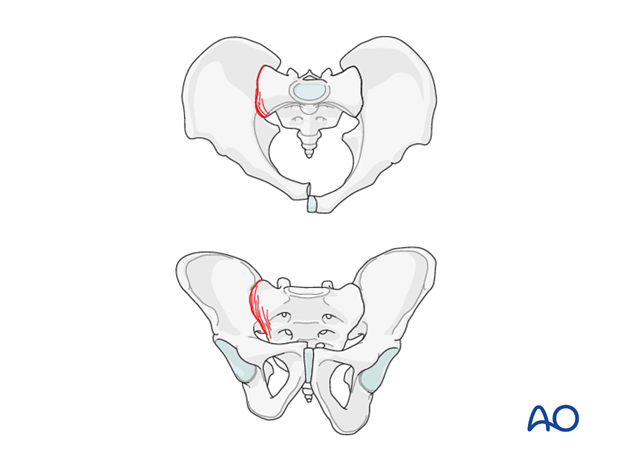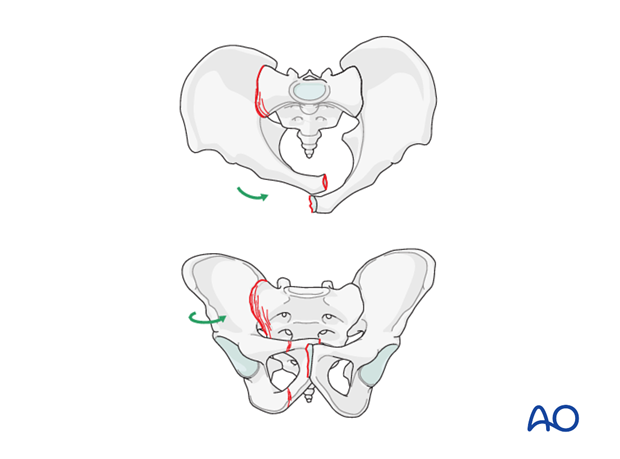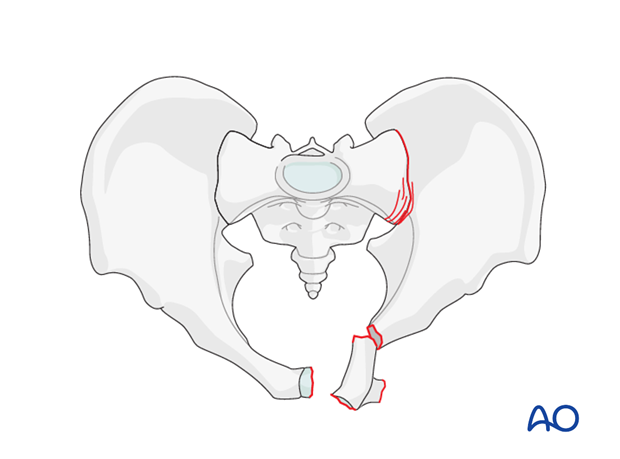Incomplete disruption of posterior arch, lateral compression fracture
Definition
Rotationally unstable and incomplete disruption posterior arch injuries (lateral compression fracture) are classified by AO/OTA as 61B2.1 and 61B2.2 fractures.
If there is no rotational instability, they are classified as 61B1.1 fractures.
Lateral compression fracture of sacrum (LC-I)
Posterior injury
The posterior ring injury is an compression fracture of the anterior sacrum (LC-I).
These are classified by AO/OTA as 61B2.1 fractures.
Anterior injury
The pelvic ring is narrowed anteriorly. The anterior arch injury, which may be unilateral on either side, or bilateral, always includes a set of horizontally oriented fractures. Impaction or overlapping of the anterior injuries is evident, and variable in degree.
Infrequently, marked internal rotation displacement through the pubic symphysis can produce a locked symphysis, with gross narrowing of the pelvic ring.
Another unusual anterior arch injury produced by internal rotation (lateral compression) is the tilt fracture. This involves dislocation anteriorly of one pubic bone with symphyseal disruption and anteriorly angulated ramus fractures.




Unilateral sacro-iliac joint fracture – subluxation (internally rotated) (LC-II)
Posterior injury
The typical lateral compression injury that disrupts the S-I joint is a “crescent fracture.” Alternatively, the fracture line may pass through the posterior iliac wing, lateral to the SI joint.
These injuries are classified by AO/OTA as 61B2.2 fractures.
The crescent is a variably sized fragment of posterior ilium which remains attached to the posterior sacroiliac ligaments, while the anterior iliac segment displaces from the sacrum.
While significantly unstable, this injury does not disrupt the ligamentous and muscular tissues of the pelvic floor. They remain as secondary stabilizers which limit displacement of the lateral hemi-pelvis.
The smaller the crescent fracture fragment, the larger the size of the S-I articular surface that remains on the anterior iliac segment. The technique chosen for repair of a crescent fracture injury will be affected by the size of the articular surface remaining on the ilium.
Crescent fractures indicate an LC-II injury in the Young-Burgess classification.
Anterior injury
The pelvic ring is narrowed anteriorly. The anterior arch injury, which may be unilateral on either side, or bilateral, always includes a set of horizontally oriented fractures. Impaction or overlapping of the anterior injuries is evident, and variable in degree.
Infrequently, marked internal rotation displacement through the pubic symphysis can produce a locked symphysis, with gross narrowing of the pelvic ring.
Another unusual anterior arch injury produced by internal rotation (lateral compression) is the tilt fracture. This involves dislocation anteriorly of one pubic bone with symphyseal disruption and anteriorly angulated ramus fractures.

















